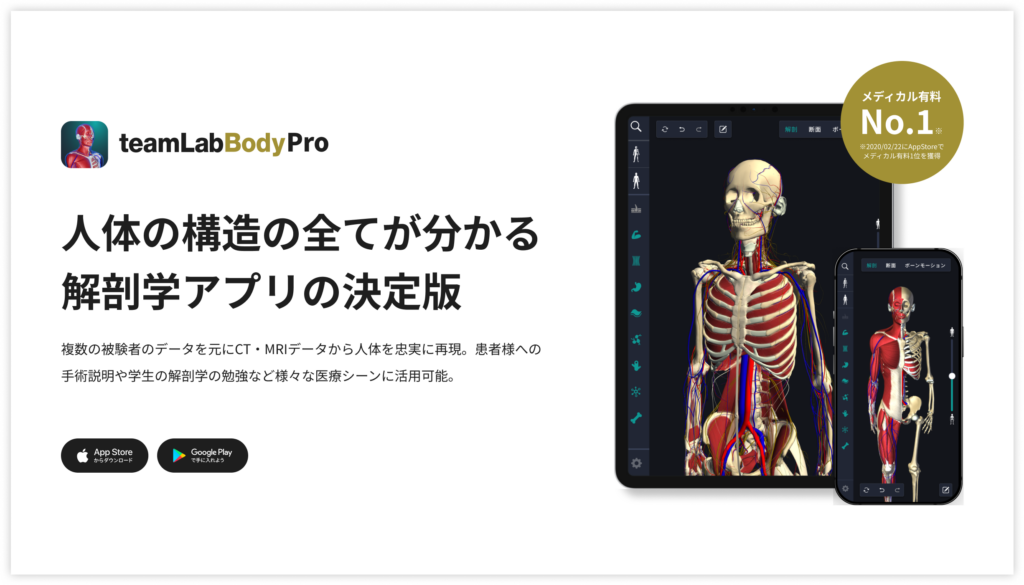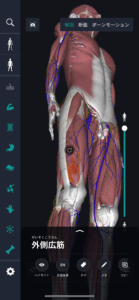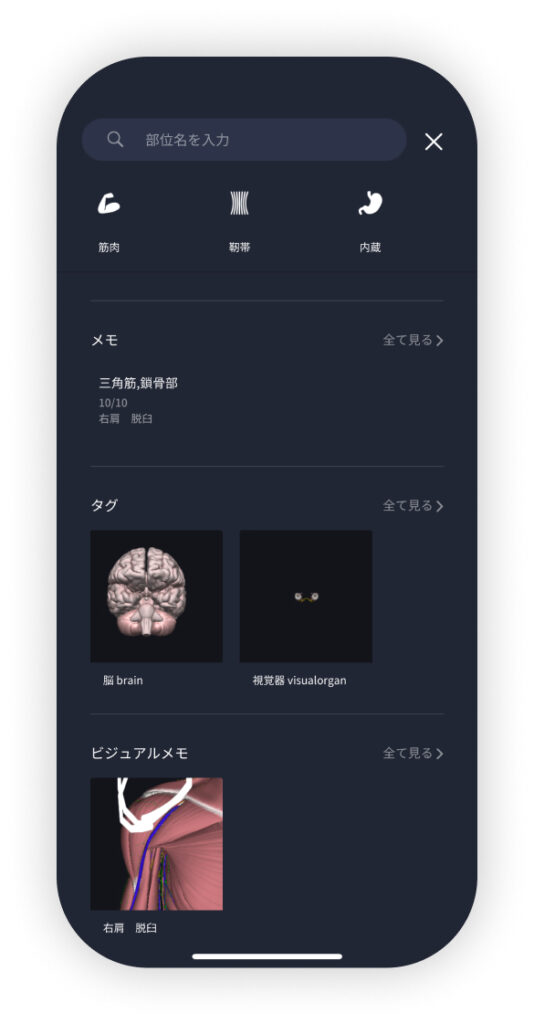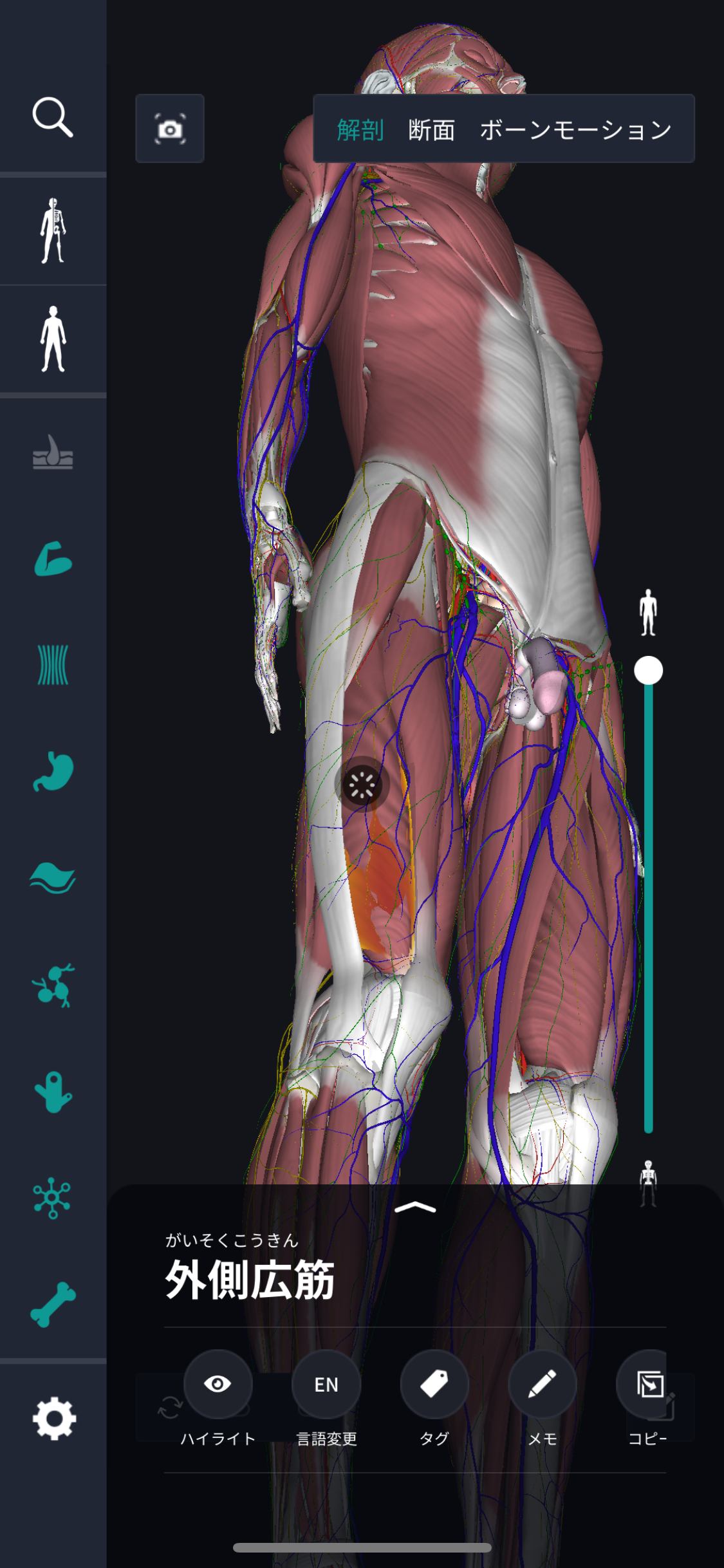beginning
In this article, I will explain effective study methods, starting with knowledge of specialized parts in human anatomy.
In human anatomy, it is necessary not only to memorize the names of various organs, muscles, and bones, but also to remember where they are located in the body. Therefore, it is necessary to learn as efficiently as possible.
I hope you can read this article and use the app to deepen your understanding even a little bit.
Now, I'll explain the details about “lateral broad muscle” and how to study human anatomy.
teamLab Body Pro Free Download
A 3D anatomy app that shows all the structures of the human body
Download teamLab Body Pro here!

What is lateralis lateralis muscle?
In the anatomy application, you can view a selection of anatomy 3D models. In this model, there are various observation methods such as surfaces, cross-sections, and nervous systems. This time, I'll explain using an anatomy application.
About lateralis lateralis muscle

The broad lateral muscle (broad lateral muscle) is a muscle belonging to the quadriceps femoris muscle and is one of the largest muscles in the human body. It is located on the front and side of the thigh and is mainly responsible for extending the knee. This muscle starts at the top of the femur and extends through the kneecap to the rough surface of the tibia. It plays a central role in everyday body movements such as walking and standing up. The lateral broad muscle also acts as a supporting structure for the body, and has the function of distributing the burden on bones and joints and making lower body movements smoother. This makes it possible to exercise efficiently while maintaining physical stability. Therefore, latissimus lateralis plays a very important role, and in particular contributes to maintaining posture while standing and propulsive force during walking. This muscle is part of the quadriceps muscle and, along with the other three muscles, covers the front of the thigh. When fatigue or stiffness occurs, knee movement and posture may be affected, but healthy movement can be maintained by being aware of muscle maintenance and management in everyday life. Stretching and moderate activity can help maintain the flexibility and strength of the broad lateral muscles.
Study points
Location and structure of lateralis lateralis muscle
The lateral broad muscle (lateral broad muscle) is a muscle located in the thigh and forms part of the quadriceps femoris muscle. This muscle is located extensively on the front and side of the femur and has a very large area. It starts at the top of the femur and extends via the kneecap to the rough surface of the tibia, and plays an important role in knee movement. Specifically, it starts near the large trochanter of the femur and reaches the outer edge of the kneecap, contributing to the body's support structure as a wide range of muscles. As for the structure of the lateral broad muscle, it mainly consists of strong muscle fibers and plays a role in stabilizing the knee joint. By adhering to the rough surface of the tibia via the patellar ligament, it exerts strong strength when stretching the knee. Also, since it cooperates with other quadriceps muscles and affects knee flexion and extension, and overall lower leg movement, its importance is high in human body exercises. Furthermore, due to its size and position, the lateral broad muscle is the foundation for supporting other muscles and tissues, and has the effect of distributing burdens during operation. Understanding position and structure helps to know how to maintain health, and by knowing how the lateral broad muscle functions during physical movement, it is possible to lead to more efficient movement.
Role and function of lateralis lateralis muscle
The lateral broad muscle (lateral broad muscle) forms part of the quadriceps femoris muscle and is mainly involved in knee extension. The quadriceps femoris muscle is the main muscle group that controls knee movement, and among them, the lateralis lateralis muscle is the muscle that exerts great strength over a particularly wide range. This muscle supports the extension of the knee and helps with exercise needed for everyday movements, such as standing up, walking, climbing stairs, or running. The lateral broad muscle also contributes to stabilizing the knee joint. It connects to the tibia through the patellar ligament and helps absorb shock while controlling knee movement. As a result, it plays a role in protecting the knee joint and preventing injuries. Furthermore, by exhibiting strength, the lateral broad muscle cooperates with other quadriceps femoris muscles (medial broad muscle, median broad muscle, and straight thigh muscle) to balance the movement of the entire thigh. When muscle strength is sufficient, it promotes efficient transmission of force and has the effect of making movement smoother. When the lateral broad muscle becomes fatigued or weak, the knee joint is likely to become unstable during walking or exercise, and the burden may increase. Therefore, it is important to maintain flexibility and function of the lateral broad muscle through strengthening and stretching this muscle. These functions contribute to improving performance when moving the body in everyday life and sports activities
English notation for lateral lateralis muscle
Lateral broad muscle is expressed as “Vastus Lateralis” in English. The name comes from Latin. “Vastus” means “wide” and “big,” and “Lateralis” means “side.” This name is directly related to the position and structure of muscles. Vastus Lateralis is part of the quadriceps femoris muscle and is widely distributed on the sides of the femur, indicating that it has a large area. Vastus Lateralis is usually used in anatomical contexts and in specialized discussions in muscle training. By using this Latin name in medical literature and research, it is possible to maintain international standardization and consistency. This helps to clearly identify specific muscles rather than common language expressions, which may not always be understood identically in different languages and cultures. Experts and researchers in particular use this English name to explain muscle function and structure. For example, in kinesiology, physiology, and anatomy textbooks, this official name is used to indicate in detail the location and role of muscles. Also, Vastus Lateralis is frequently mentioned in muscle training and physical therapy situations, and this name is important when identifying target muscle groups and designing training menus.
How to study human anatomy
I will explain specific study methods using human anatomy applications.
Check your past learning history and practice repeatedly
Here are the steps to check your anatomy learning history and practice iteratively effectively.
1. Check your learning history in the app
Reviewing your learning history with the application is an important step in effectively advancing anatomy learning. First, launch the app and go to the learning history section from the main menu. Many anatomy apps are designed to show your progress in the form of graphs and lists, so you can visually check which parts you've learned about and how much time you've spent.
By using this data, you can understand which areas you have strengths in and where you need to spend more time and effort. We also recommend using a dedicated tag or notebook function to mark areas you are particularly weak at or where you need to relearn. Regularly checking your learning history and looking back on past learning content will lead to efficient review and deepening understanding.
2.Make a plan for iterative learning
Making an efficient repetitive learning plan based on learning history is extremely effective in promoting knowledge retention. First, identify weak points and areas where you need to relearn. Next, arrange these study items into a weekly or monthly calendar and create a specific study schedule. By proceeding in a planned manner, you can learn each part evenly and avoid packing in a large amount of information at once.
Using a task management app or digital calendar to set study reminders is effective. Also, it's important to have the flexibility to regularly review progress and revise plans as needed. By having goals and proceeding with your studies in a planned manner, you can efficiently acquire anatomical knowledge.
3.Use 3D features to learn visually
By utilizing the 3D function, learning anatomy is easier to understand visually. The 3D model shows the structure of the human body three-dimensionally, and each part can be observed in detail. This makes it possible to intuitively grasp positional relationships between deep muscles and organs that are difficult to capture in a planar view. For example, you can learn even the smallest details by rotating specific muscles and bones and zooming in and out.
Also, there are many apps that have the function of displaying cross-sectional views of each part using a 3D model, which is useful for deepening understanding of internal structures. This diversity of visual information helps with memory retention and improves immediate responsiveness in tests and practice situations. By utilizing the 3D function and learning visually, you can learn anatomy knowledge more deeply and efficiently.
Use the memo function concretely

Make notes so you don't forget the things and points you've noticed while studying. The memo function can be used for different purposes, such as inputting text, saving images, and writing memos. Tag your notes to make them easier to review later.
Test your learning regularly in the form of quizzes
Regularly testing what you've learned in a quiz format is a very effective way to anchor your anatomy knowledge. Quiz-style tests help you objectively grasp your level of understanding and areas you lack while repeating knowledge.
For example, by using a learning app to conduct quizzes every specific period, you can reconfirm what you've learned and strengthen your memory. There are a wide range of quiz formats, such as multiple choice questions, fill-in-the-blank questions, and short answer questions, and each helps understanding from a different angle and develops the ability to utilize various types of knowledge.
Get feedback
If possible, get feedback from other learners and experts. It helps you find your own gaps in understanding and areas for improvement. You can also keep yourself motivated to learn by regularly testing yourself. Feeling a sense of accomplishment and progress increases motivation for continuous learning.
summary
This time, I explained how to study “lateral broad muscle” using an application!
Thank you for reading this far.
I would be happy if reading this article helped you learn about anatomy.
Learning is a long, never-ending journey, but I sincerely wish you all the best. Let's continue to study together and work hard for the national exam!
Please look forward to the next blog.




